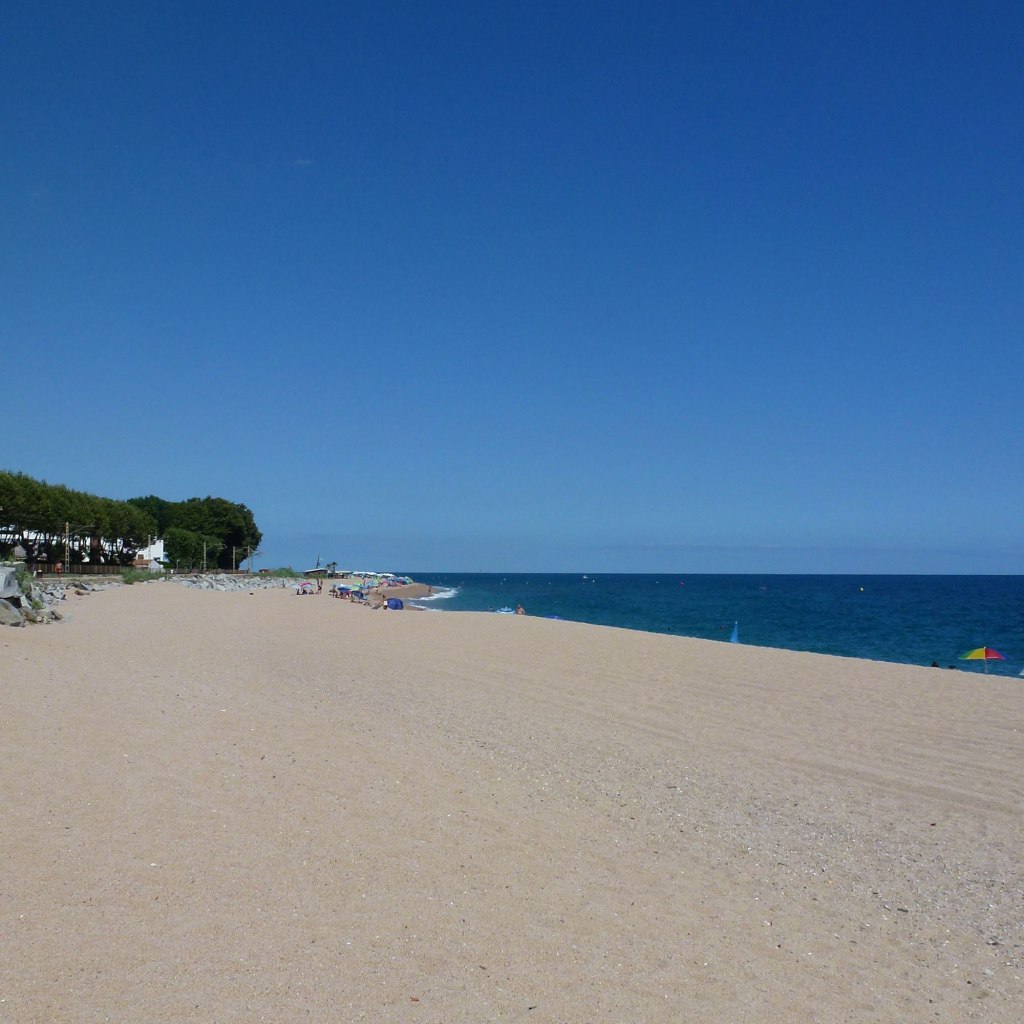I have already spotted the empty areas on the beach of Can Villar while the train enters the station of Sant Pol de Mr, where I get off. It’s a bright sunny Sunday and I need some time off the city.

“When in doubt, paddle out” the surfers say, and it’s exactly what I did today – paddle out the big city with its new restrictive anti-covid measures, and take refuge in one of the places I feel particularly fond of, Sant Pol de Mar.

Sant Pol de Mar is at about 40 minutes by train from Barcelona, on the coast of Maresme. The place has a bit of everything: narrow winding streets, medieval churches, Modernist mansions, places with good food, pine-covered hills and, above all, ten beaches to its name.
I am going to Sant Pol on usual basis, and here are some of the places I enjoyed the most, throughout the last four summers.
Beaches

Going north, there are several beaches that offer rocky spots, pine tree shadow, and sandy space to spread out and sunbathe. My favourite is Platja Rocagrossa, at a 20-minute walk from the train station in the direction of Calella.

Rocagrossa – meaning the big rock, is the youngsters’ favourite spot for jumping into the seawater.

At the southern end of Sant Pol, Platja de les Roques Blanques is a wilder stretch of beach popular with nudists. Metres away from the railway station there’s the town’s main beach, a cove shared between bathers and the nautical club, while Platja del Morer is a tiny stretch north of the centre.
The Town

At midday, when the sun is too strong, I usually take refuge in the shadow of the streets, and each time I find a new place, be it a small square, some picturesque stairways, a house, a park, even a tiny detail.

To me, the most iconic facade is that of Can Planiol. It is the work of local architect Ignasi Mas i Morell, comissioned by Ramon Planiol – nicknamed the Americano. The two were friends and travelled together to Havana, where the architect resided between 1907 and 1910.

Perhaps as a reminder of his remote residency, Can Planiol features, on the main facade, the coat of arms of Sant Pol de Mar as well as the flag of Cuba. The house is a sample of playful Modernist trencadís whilst the shapes are simple and elegant. The terraced consoles of the balcony are of particular charm.
Also on Abat Deas street, several houses for the families who got back from America were built, between 1870 and 1880. Their gardens, Els Jardins del Pla, are right across the street from the houses, and were created in order to preserve their open views towards the sea. The vegetation includes native plants but also trees that reminded the owners of their stay in America: the high palm trees.

Ermita de Sant Pau is the landmark par excellence of Sant Pol. The town owes its origin to this monastery dating from the 10th century. In the medieval period, the town lived a period of splendor due, in large part, to the wealth and economic activity generated by the monastery. It was also an important cultural centre with a library and a scriptorium, and the prior was in charge of buying the books for the king.

The remains of the former Benedictine monastery sit atop a small hill overlooking the town. The hermitage displays a fusion of architectural styles: only the apse and one window of the northern facade remain of the original building. Other elements date from later Romanesque times, following its fortification in the 13th century.

From this point, the church offers sweeping views across the town, the Mediterranean and the gardens below.

Back into town, its winding streets lead to another church, stopping by some lovely places, such as this tiny square, with its shadowing olive tree, colourful plants and a landmark worth having in mind, the house where the Sant Pol born abbot of Montserrat, Josep Deàs i Villardegrau, was born.


The promenade by the sea is sprinkled with eateries, and the one I warmly recommend is Xaloc restaurant.

Last time I went here with my friends we had a juicy seafood rice, one of the best I’ve tried so far.

Further Little Details and Interesting Places







Other Outdoor Places and Routes

A Route from Cadaques to Cap de Creus. A “grandiose geological delirium” as Salvador Dalí described it, the area is sprinkled with picturesque villages, pristine coves and, above all, an out of this world array of phantasmagorical rocks shaped by the gale force of the tramuntana wind and the swirling waters of the Mediterranean.

Montserrat. There are many reasons to go to Montserrat, this mountain is unique – almost strange in its uniqueness. Montserrat translates to “saw mountain” in Catalan, owing the name to its jagged appearance that projects upwards to the sky, dominating the landscape and fully justifying the name it’s been given.
